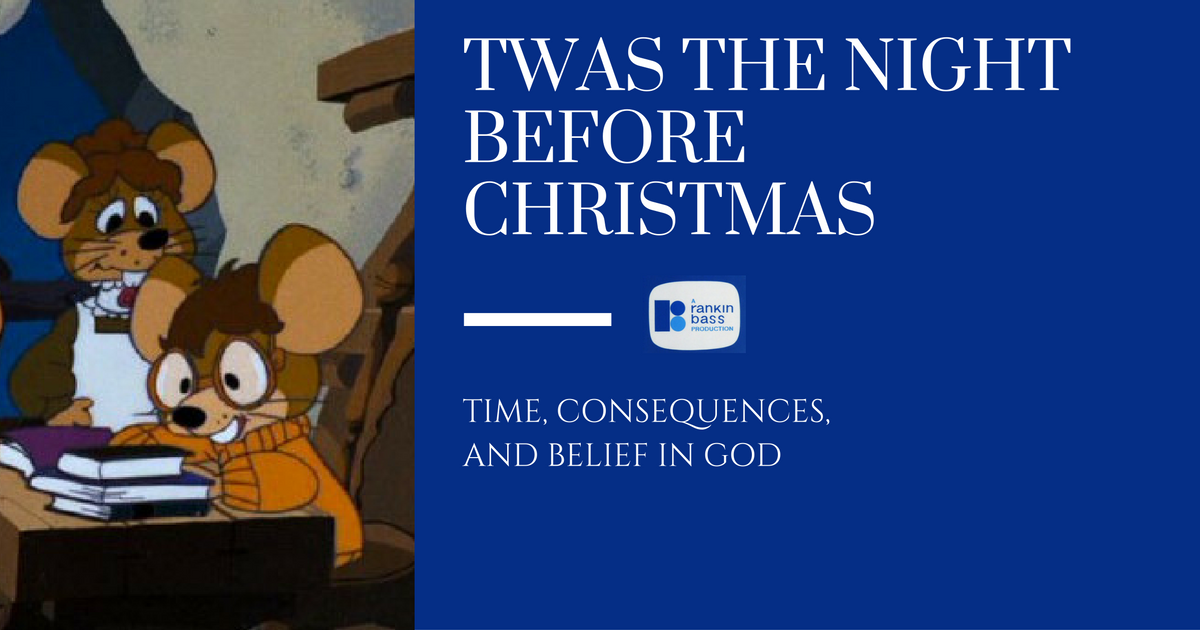
The end of our first week ends on a celebratory note. Mama in her kerchief and I in my cap, let’s settle down for a long winter’s nap with Twas the Night Before Christmas!
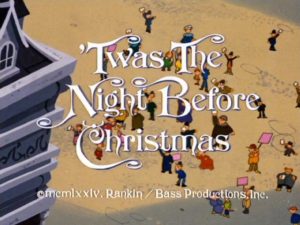
I will admit to leaping to some wild conclusions in this series. I feel a little guilty about that sometimes, but it’s nothing compared to what Rankin-Bass accomplished here. Twas the Night Before Christmas is a masterclass in pulling plot points and themes seemingly out of thin air and developing them into a fully cohesive plot. And while we just spent an entire special understanding Santa as a man, this time we will understand him as a God.
Like Frosty the Snowman, this is another animated special. Rankin-Bass worked with Topcraft rather than Mushi Productions this time, and many of the animators who worked on Twas the Night Before Christmas would actually go on to later form Studio Ghibli. The difference in quality is fairly unapparent at first, though there’s far more distinction to individual characters this time around. You can notice a wider variety of body types and facial shapes, and the (admittedly nameless) black family seen in an early montage also gives Twas the Night Before Christmas a much-needed minor shot at diversity, though it wouldn’t be until 2001’s Santa Baby! that Rankin-Bass would ever actually give prime narrative space to a non-biblical person of colour.
We begin Twas the Night Before Christmas at the end, three minutes to midnight on Christmas Eve. Literally, twas the night before Christmas. We immediately get a full glimpse all through the house. Everybody seems anxious. They’re waiting for the clock to strike to see if Santa will even arrive. It’s an early indicator that this entire special is themed around the concept of time. It’s a countdown. Like High Noon, every aspect of Twas the Night Before Christmas highlights that ticking of the clock, and passage of time. We know we’re destined to return to this moment of anticipation. Of course, it’s not only people that are waiting for the clock, but mice as well.

Let me talk about the mice. It’s the age-old story fix-it method, isn’t it? Just add mice. Ordinarily I would dismiss it as cheap, but In this case, it’s a built in feature. Not a creature was stirring not even a mouse. It obviously means mice are the protagonists of this tale, and obviously they must be stirring in order to create a cohesive narrative. It’s the one element we’re allowed to play with, adding action where previously there was none.
While the stockings were hung by the chimney with care, the joyful Christmas morning is not ensured. It’s all been done in hopes that Saint Nicholas soon would be there. In hopes. It’s unsure. From here, we can be free to invent where we want. We’ve taken apart the basis of what this poem means and, as long as we come back to it in the end, which we will, we have some creative freedom to make up the middle section as we choose.
The reason for everyone’s anxiety is that Santa recently returned all letters from Junctionville unanswered, seemingly forsaking the town of Junctionville because of a letter that was sent to him claiming he didn’t exist, signed ‘all of us’ from an anonymous source. It seems sort of petty for Santa to do this to an entire town, but as Santa works in mysterious ways. This idea that Santa is something to be believed in, that you have to take him on faith alone, is really the first time Rankin-Bass addresses the fact that Santa may not be real, at least from the perspective of the kids waiting desperately deliverance under their tree.
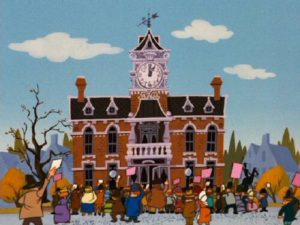
How do we do that while still driving home time in every instant? The plan is to make him happy again with a clock that will play a song of children singing how much they love and appreciate his visits. Yup, this Santa is a stand in for God if there ever was one. Build Him an altar so He may know how much we do adore Him. At midnight when he flies over Junctionville, he’ll hear a children’s song and be moved by its enchanting tones. Again, we have time as a character present within the story, not necessarily as a thematic element, but as a dramatic one at the forefront of how we approach every scene.
It turns out the letter can be traced back to Albert, Father Mouse’s son who is distinctive for his use of long words. He’s the Doubting Thomas of Twas the Night Before Christmas, and needs to see in order to believe. And he doesn’t believe in Santa. He speaks for the whole town in the way only a child can feel with absolute certainty that he’s the smartest person in the room. Even when questioned, he’s insistent that his way is right. He’s thought it through and Santa cannot, must not exist, and it would better for the whole town to stop believing. Rankin-Bass has now introduced evangelical atheism into a Christmas special, and I actually really like how his story plays out.
Father Mouse (seriously, I IMDb’d this just to be safe but that is his name) takes Albert around the city, introducing scenes as examples of “how you ruined everyone’s Christmas with your opinions,” in the most hilariously cruel way a father can talk to a son. You can see this as a generational battle where Father Mouse has never questioned his faith and cannot fathom why his son has. He’s showing Albert the benefits of belief and what these people have lost by Santa forsaking them.

As the whole town gathers to see the clockmaker’s clock sing, all hope is suddenly lost. The clock fails. This is such a disheartening moment, and Rankin-Bass twist the knife even further by again showing that actions have consequences. Because the clock failed, the clockmaker loses all his business. Because the clockmaker falls on hard times, so too do the mice. Meals don’t fall from empty tables. And it’s all Albert’s fault. He climbed into the clock to see how it worked, to see the mechanism behind faith, and broke it.
He’s made a mistake and he has to fix it. And the inspiration comes from the human side of the story, as the clockmaker tries to bring his children’s spirits back up with a song that helpfully explains everything Albert needs to know, Even a Miracle Needs a Hand. It’s a song about having to get off your butt and work to make miracles happen. I have to say, after enduring a few religious specials already, this special gives a refreshingly philosophical take on the whole idea. I’m most impressed because this method of thought allows Santa to exist in an intelligent world. Yes, Albert. There is a Santa Claus. And of course you have to make him real. Albert’s voice cracking at the end of this song is a moving moment. He understands that even if Santa doesn’t exist, he was wrong for denying anyone the magic of belief, and he’s truly sorry.
But it’s not enough to be sorry. You need to correct what you did.
Albert asks Father Mouse is Santa Claus is going to come. “I don’t know…” It’s a crisis of faith. He sees his father questioning something he’s never questioned before. Do our efforts mean anything here on Earth, or are we truly helpless in the face of an omnipotent God? Albert decides they do. He’s seen both sides of the problem and he scurries off into the night.
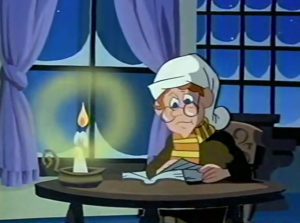
Silent Night. This is a nice way to slip another carol organically into the plot in a way I’m surprised doesn’t happen more often. In a film that’s consistently pushed time, deadlines, and anticipation dramatically, it feels right to take a silent moment and allow the story to breathe. A moment of silence is all-important to make you feel that. At this point in the story, we don’t know how it’s going to be solved. Our best chance has already been thwarted.
Suddenly, the clock springs to life! Even the nameless black family returns to anxiously await the clock. Albert has fixed it! He made Christmas happen for everyone else, not himself. Christmas is about putting others first.
Here’s proof of how well they were able to stretch the themes and ideas of the original Twas the Night Before Christmas. The special ends with a reading of the poem, with the action on screen matching the rhyme as a triumphant climax to the entire picture. Not only is it a climax of the plot, but of the production. It stands proudly and proclaims victory over this short story. It adapted it. It conquered it. And it feels all the sweeter for how much this moment was built up to in the preceding 25 minutes.
One quick note about the Santa Claus we see here, as he’s fairly unique to the canon. This is the “right jolly old elf” whose presence is a miracle in Twas a Night Before Christmas. It can’t merely be a man with a red coat and history of dismantling fascism. They honour Clement Moore’s creation with a depiction that’s boldly faithful to the original text, while also being representative of how the Japanese animators may have created their own abstracted version of Santa from these described elements. There’s a bit of a mistranslated element to his design.
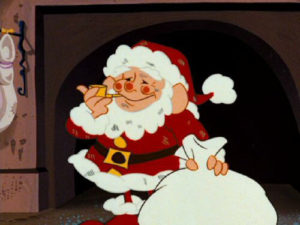
I have fond memories of Twas The Night Before Christmas from childhood, but as a child I never realised how well it set itself to work. Like a clock itself, it’s made up of many separate moving pieces that all work together to serve a single purpose. Rankin-Bass correctly identified the strength of the poem as a climax and let its entire special literally be a countdown to that moment. It’s the strongest one-off in Rankin-Bass canon, and the fact that it stands with the heavy hitters of Rudolph, Frosty, and Santa is as much of a compliment as I could ever give. And it’s better than The Little Drummer Boy, because everything is.
1. Rudolph the Red-Nosed Reindeer
2. Frosty the Snowman
3. Santa Claus is Comin’ to Town
4. Twas the Night Before Christmas
5. The Little Drummer Boy
Look forward to tomorrow’s party with Heat Miser and Snow Miser as I visit The Year Without a Santa Claus!


![[LIST] SUMMERTIME DREAD: DAYLIGHT HORROR MOVIES PERFECT FOR SUMMER](https://geekd-out.com/wp-content/uploads/2021/06/daytimehorrorheader-150x150.jpg)
![[REVIEW] DOES CLAREMONT RETURN TO GLORY IN ‘GAMBIT #1?’](https://geekd-out.com/wp-content/uploads/2022/07/background-1-150x150.jpg)
